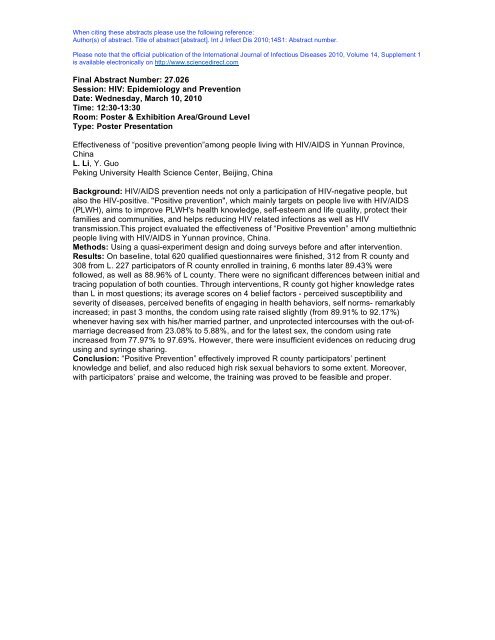14th ICID - Poster Abstracts - International Society for Infectious ...
14th ICID - Poster Abstracts - International Society for Infectious ...
14th ICID - Poster Abstracts - International Society for Infectious ...
Create successful ePaper yourself
Turn your PDF publications into a flip-book with our unique Google optimized e-Paper software.
When citing these abstracts please use the following reference:<br />
Author(s) of abstract. Title of abstract [abstract]. Int J Infect Dis 2010;14S1: Abstract number.<br />
Please note that the official publication of the <strong>International</strong> Journal of <strong>Infectious</strong> Diseases 2010, Volume 14, Supplement 1<br />
is available electronically on http://www.sciencedirect.com<br />
Final Abstract Number: 27.026<br />
Session: HIV: Epidemiology and Prevention<br />
Date: Wednesday, March 10, 2010<br />
Time: 12:30-13:30<br />
Room: <strong>Poster</strong> & Exhibition Area/Ground Level<br />
Type: <strong>Poster</strong> Presentation<br />
Effectiveness of “positive prevention”among people living with HIV/AIDS in Yunnan Province,<br />
China<br />
L. Li, Y. Guo<br />
Peking University Health Science Center, Beijing, China<br />
Background: HIV/AIDS prevention needs not only a participation of HIV-negative people, but<br />
also the HIV-positive. "Positive prevention", which mainly targets on people live with HIV/AIDS<br />
(PLWH), aims to improve PLWH's health knowledge, self-esteem and life quality, protect their<br />
families and communities, and helps reducing HIV related infections as well as HIV<br />
transmission.This project evaluated the effectiveness of “Positive Prevention” among multiethnic<br />
people living with HIV/AIDS in Yunnan province, China.<br />
Methods: Using a quasi-experiment design and doing surveys be<strong>for</strong>e and after intervention.<br />
Results: On baseline, total 620 qualified questionnaires were finished, 312 from R county and<br />
308 from L. 227 participators of R county enrolled in training, 6 months later 89.43% were<br />
followed, as well as 88.96% of L county. There were no significant differences between initial and<br />
tracing population of both counties. Through interventions, R county got higher knowledge rates<br />
than L in most questions; its average scores on 4 belief factors - perceived susceptibility and<br />
severity of diseases, perceived benefits of engaging in health behaviors, self norms- remarkably<br />
increased; in past 3 months, the condom using rate raised slightly (from 89.91% to 92.17%)<br />
whenever having sex with his/her married partner, and unprotected intercourses with the out-ofmarriage<br />
decreased from 23.08% to 5.88%, and <strong>for</strong> the latest sex, the condom using rate<br />
increased from 77.97% to 97.69%. However, there were insufficient evidences on reducing drug<br />
using and syringe sharing.<br />
Conclusion: “Positive Prevention” effectively improved R county participators’ pertinent<br />
knowledge and belief, and also reduced high risk sexual behaviors to some extent. Moreover,<br />
with participators’ praise and welcome, the training was proved to be feasible and proper.
















